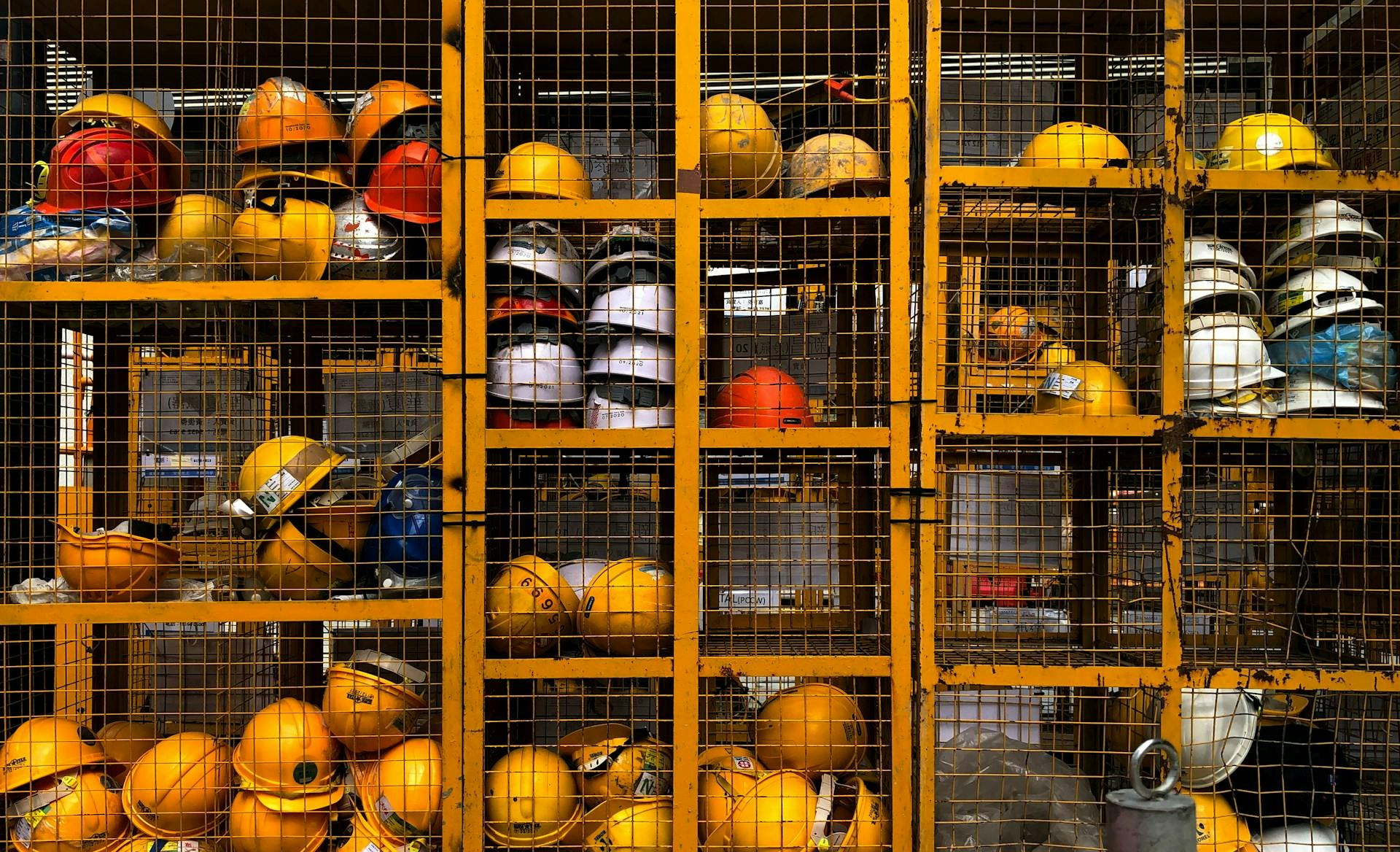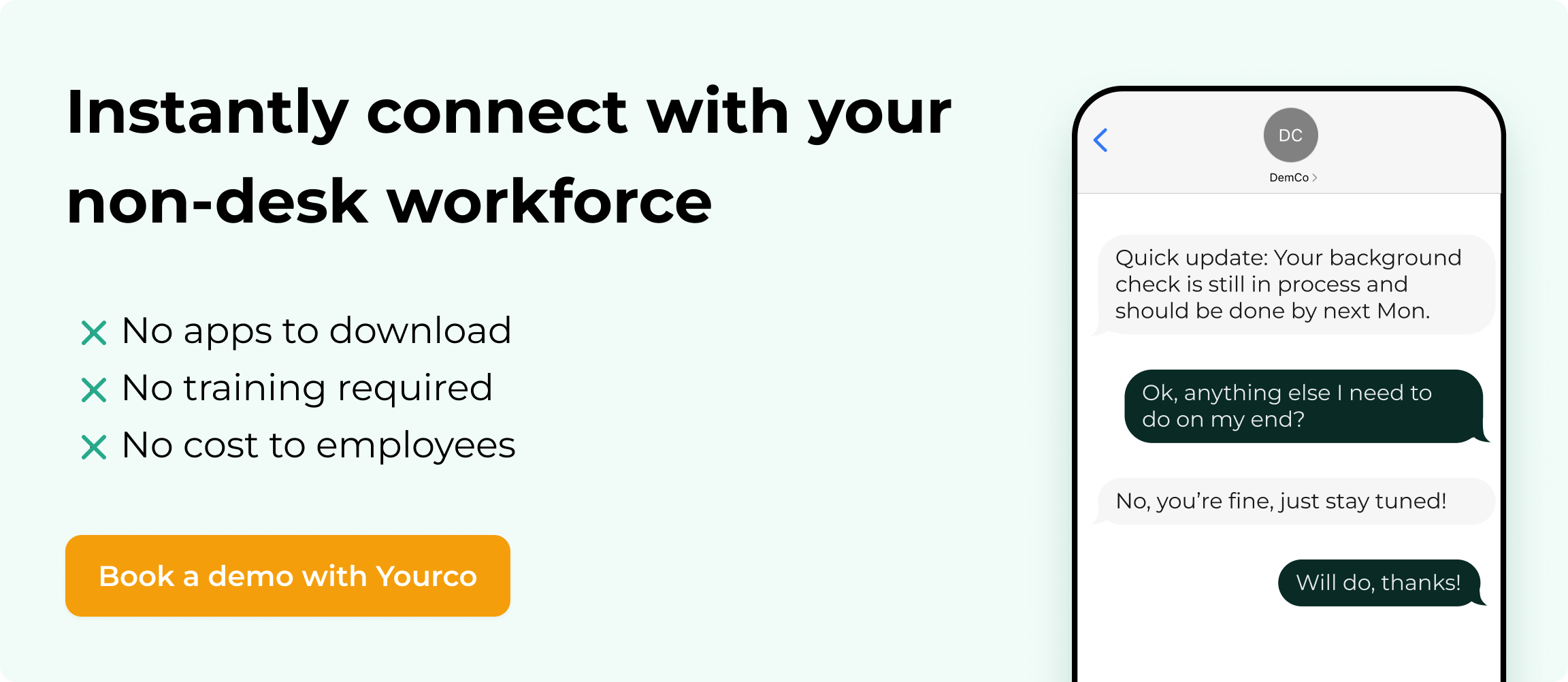Top Tips for Improving Employee Safety Awareness in Non-Desk Industries


Workplace safety awareness saves lives and protects companies' bottom lines. Injuries cost businesses billions annually through medical expenses, lost productivity, equipment damage, and decreased morale. Building strong safety awareness demands commitment from all organizational levels.
This article explores comprehensive strategies to improve safety awareness in the workplace, addressing both physical and psychological aspects.
How to Assess Your Current Safety Culture to Improve Workplace Safety Awareness
Before implementing new safety initiatives, you need to understand your starting point. A weak safety culture shows itself through obvious signs: spotty safety communications, minimal leadership involvement, and employees who see safety as a burden.
To gauge your current safety culture and improve safety awareness in the workplace, conduct a thorough assessment examining both formal systems and daily practices. Start by reviewing existing safety documents, incident reports, workplace safety rules, and previous audit results to spot patterns.
Employee feedback offers gold when assessing safety culture. Try these approaches:
- Anonymous surveys that let workers honestly share concerns
- Focus groups to discuss specific safety challenges
- One-on-one interviews with representatives from different departments
When gathering feedback, pay attention to the unique challenges your non-desk employees face:
- Language barriers that prevent full understanding of safety protocols
- Time constraints and production pressure that lead to safety shortcuts
- Inadequate or uncomfortable personal protective equipment (PPE)
Your assessment should identify specific gaps in your current safety practices. Are hazard reporting processes accessible to all employees? Do safety training address real-world scenarios workers encounter?
Is there consistent enforcement of safety protocols across all shifts and departments? Additionally, consider the effectiveness of your non-desk employee onboarding processes in communicating safety protocols.
Finally, establish metrics as baselines for measuring future improvement. These might include incident rates, near-miss reporting frequency, safety training completion rates, and results from safety perception surveys. Having clear baseline measurements will allow you to demonstrate real progress as you implement new safety initiatives.
Building a Comprehensive Safety Communication Strategy to Enhance Safety Awareness
Developing an effective safety communication strategy is essential for a strong safety culture and improving safety awareness in the workplace. This includes communicating safety protocols clearly and effectively.
The goal is to establish clear safety objectives and create consistent messaging that reaches every employee, regardless of their role or work environment.
Communication Strategies for Non-Desk Employees to Improve Safety Awareness
When it comes to communicating safety information, the biggest challenge many organizations face is reaching their non-desk workforce. Effective communication for non-desk workers requires adapting traditional methods. Traditional communication channels like email and intranet portals often fail to engage frontline workers who don't have constant access to computers or company email.
Mobile-first approaches are proving far more effective in facilitating deskless worker communication:
- SMS-based platforms: Text messaging is particularly powerful for reaching non-desk employees. SMS messages have an impressive 98% open rate compared to just 20% for emails. This makes text messaging an ideal channel for urgent safety alerts, brief reminders, and timely updates.
- QR code-based reporting: Manufacturing companies have found success implementing QR codes throughout their facilities that workers can scan with their smartphones to quickly report safety concerns or access safety information. This approach reduces barriers to reporting and puts safety resources at employees' fingertips.
Implementing communication strategies for deskless workers such as these can enhance safety awareness. For maximum effectiveness, incorporate visual elements into your mobile communications.
Photos, icons, and short videos can convey safety concepts quickly and memorably, especially in noisy environments where reading detailed text might be challenging.
Overcoming Language and Literacy Barriers to Enhance Workplace Safety Awareness
A truly comprehensive safety communication strategy must address the diverse needs of your workforce, including language differences and varying literacy levels:
- Provide safety materials in multiple languages based on your workforce demographics, including emergency alerts in Spanish
- Use universal safety symbols and color coding whenever possible
- Create visual guides that rely more on images than text
- Develop simple, consistent terminology for safety concepts
- Offer audio versions of written safety materials
Consider implementing a buddy system where more experienced workers can help reinforce safety messages with colleagues who might face language or literacy challenges.
This peer-to-peer approach not only overcomes communication barriers but also strengthens your overall safety culture. When hiring non-English speaking employees, it's important to provide adequate support to integrate them safely into the workplace.
Consistent Messaging Across Channels
For safety communication to be effective and improve safety awareness in the workplace, your messages need to be consistent across all channels while being appropriately tailored to each medium.
- Determine core safety messages: Identify the most important safety information that needs to reach all employees and create standardized language for these messages.
- Channel mapping: Match specific types of safety communications with the most appropriate channels. For example, use SMS for urgent alerts, digital signage for ongoing reminders, and team meetings for more detailed discussions.
- Create a safety communication calendar: Develop a calendar that schedules regular safety communications throughout the year. This ensures consistent delivery of safety information and prevents communication gaps or overwhelming employees with too many messages at once.
Reviewing examples of employee communication can help in designing effective messages that resonate with your workforce.
- Visual consistency: Use consistent visual elements, such as logos, colors, and icons, across all safety communications to create instant recognition.
- Feedback loops: Establish mechanisms for employees to ask questions and provide feedback on safety communications. This two-way communication is essential for ensuring messages are being understood as intended.
Implementing these strategies and consistently evaluating their effectiveness helps build a safety communication approach that reaches all employees and genuinely influences safety behaviors. By focusing on methods to improve team communication, organizations can ensure safety messages are understood and acted upon.
Remember that effective employee communication isn't about the volume of messages sent but about how well those messages are received, understood, and acted upon by your workforce.
Implementing Microlearning to Improve Safety Awareness in the Workplace
Microlearning has emerged as one of the most effective approaches for safety training, especially for non-desk workers. This method focuses on delivering short, focused learning units that cover one specific topic at a time, making it ideal for busy work environments where extended training sessions are impractical.
Benefits of Bite-sized Learning for Retention
The traditional approach of day-long safety training sessions often results in information overload and poor retention. Microlearning addresses this by breaking complex safety topics into manageable chunks that are easier to process and remember.
Main benefits include:
- Improved information retention through spaced repetition
- Higher engagement rates as content is quick to consume
- Reduced cognitive load focusing on one concept at a time
- Just-in-time learning that can be accessed when and where needed
Research shows that microlearning aligns with how our brains naturally process information. When safety information is delivered in bite-sized portions, employees are 80% more likely to retain safety protocols compared to traditional training methods.
For non-desk workers specifically, who often can't step away from their duties for long periods, microlearning provides flexible learning opportunities that fit into natural breaks in the workday.
Creating Effective Microlearning Content
Effective microlearning content for safety training should be concise, focused, and action-oriented. Here are some proven formats that work particularly well:
- 2-3 minute video tutorials demonstrating proper equipment operation
- Visual infographics illustrating correct PPE usage for specific tasks
- Digital safety checklists that can be completed before starting hazardous work
- Brief interactive quizzes reinforcing safety concepts
- Audio snippets explaining safety protocols that can be listened to while working
The goal is to ensure each microlearning unit covers just one learning objective and includes a clear call to action. For example, a microlearning module on fall protection shouldn't attempt to cover all aspects of height safety but might focus specifically on proper harness inspection.
When creating microlearning content, consider the environment where it will be consumed. For industrial settings, content should be designed to be easily viewed on mobile devices, even in poor lighting conditions or noisy environments. Visual-based learning often works best for non-desk workers who are typically hands-on learners.
Integrating Microlearning into Daily Workflows
The most successful microlearning programs are those that seamlessly integrate into existing workflows rather than disrupting them. Here are strategies for effective implementation:
- Use QR codes on equipment that link to short instructional videos on proper operation and safety procedures
- Implement a mobile delivery system that sends safety reminders at relevant times (e.g., weather alerts for outdoor workers)
- Create a library of microlearning resources that employees can access on-demand when facing unfamiliar tasks
- Schedule regular, brief safety moments at the start of shifts using microlearning content as discussion starters
Delivering the right information, at the right time, in the right format, microlearning helps organizations build a culture where safety becomes an integrated part of everyday work rather than a separate, burdensome activity.
The most important factor is consistency and relevance—small doses of safety information delivered frequently and contextually will have a far greater impact than occasional intensive training sessions.
Using Technology for Enhanced Safety Awareness
Technology offers practical solutions to improve safety communication, training, and monitoring for non-desk workers. Companies can reduce workplace incidents while building a stronger safety culture through tools designed specifically for frontline employees.
Interactive Video and Simulation Training
Traditional safety training often fails to engage workers or demonstrate the real consequences of safety violations. Interactive video training provides accessible alternatives to classroom learning:
- 360-degree videos that show workplace hazards from multiple angles
- Interactive video scenarios where workers choose different response options
- Simple computer simulations of common workplace procedures
- Mobile-based scenario training that can be completed during downtime
Beyond training simulations, affordable technology is also being incorporated directly into workers' daily routines to actively monitor and improve safety conditions. Wearable sensors can track movement and alert workers to ergonomic risks, while smart badges detect exposure to hazardous environments.
Accessible Safety Monitoring Tools
Simple technology solutions are transforming how companies monitor and prevent workplace injuries:
- Smartphone motion sensors that detect slips, trips, and falls, automatically triggering alerts.
- QR code-based equipment inspection systems that ensure compliance and track maintenance history.
- Digital safety checklists on tablets mounted at workstations, improving accuracy and accountability.
- Simple alert systems for hazardous areas or equipment, such as emergency notifications and automatic lockout procedures.
- Bluetooth beacons that remind workers about required PPE in specific zones, reducing non-compliance risks.
- Wearable devices that monitor worker fatigue and environmental conditions, preventing accidents before they happen.
While monitoring technology tracks safety in real-time, mobile applications provide workers with instant access to updated safety protocols, training materials, and emergency contacts, keeping them informed and protected on the job.
Mobile Applications for Safety Management
Mobile safety solutions bridge the communication gap for non-desk workers who can't access company intranets or emails during their shifts. These specialized tools enable:
- Instant access to safety procedures and reference materials
- Real-time hazard reporting with photo/video documentation
- Two-way communication between workers and safety managers
- Quick safety checks before starting potentially dangerous tasks
- Immediate incident reporting and emergency response coordination
Cloud-based safety management systems complement these mobile tools streamlining safety documentation and making it accessible from any device. These systems centralize incident reports, inspection results, training records, and compliance documentation—creating a single source of truth for all safety-related information.
The benefits of these technological solutions extend beyond just convenience. Making safety information more accessible and engagement more intuitive creates a more responsive safety culture where hazards are identified and addressed promptly, communication flows more freely, and everyone shares responsibility for workplace safety.
How to Improve Safety Awareness in the Workplace Through Meaningful Employee Engagement
When it comes to building a strong safety culture, nothing is more powerful than employee involvement. When your team members feel ownership over safety protocols, they're more likely to follow them and encourage others to do the same. Here are effective strategies for creating meaningful engagement that transforms safety from a top-down mandate to a shared responsibility.
Establishing Effective Safety Committees
A well-structured safety committee brings together perspectives from across your organization to identify hazards, solve problems, and drive continuous improvement. For maximum effectiveness:
- Include representation from all levels of the organization—from frontline workers to management
- Establish clear roles, responsibilities, and meeting cadence
- Empower the committee with authority to make recommendations and implement changes
- Create channels for two-way communication between the committee and the broader workforce
- Recognize and celebrate committee achievements
The most successful safety committees combine practical experience with leadership support. When committee members see their suggestions taken seriously and implemented, engagement naturally increases and spreads throughout the organization.
The Safety Champions Program
While safety committees provide formal structure, a Safety Champions program takes employee involvement to the next level creating a network of safety advocates embedded throughout your operation. Here's how to build an effective program:
- Selection: Look for employees who demonstrate natural leadership, show commitment to safety, and have the respect of their peers. Consider allowing teams to nominate their champions rather than having management make all selections.
- Training: Provide champions with additional safety training, including hazard identification, communication skills, and how to positively influence peers. This specialized knowledge builds their confidence and credibility.
- Empowerment: Give champions clear responsibilities such as conducting pre-shift safety talks, performing informal observations, and collecting feedback from coworkers. Ensure they have management support to fulfill these duties.
The peer-to-peer approach is particularly effective because experienced workers can share practical knowledge in ways that resonate with their colleagues. Unlike classroom-style training, this learning happens naturally within the workflow, making safety practices more likely to stick.
Interactive Safety Activities and Competitions
Beyond formal roles and responsibilities, creating engaging activities brings safety awareness to life in fun, memorable ways. Consider implementing:
- Safety scavenger hunts that challenge teams to identify hazards or safety equipment
- Themed safety weeks focusing on specific topics like fall protection or ergonomics
- Interactive challenges where departments compete to identify the most improvement opportunities
- Safety innovation contests that encourage creative problem-solving
Providing employee incentives for deskless teams encourages participation and reinforces the importance of safety.
These activities work because they transform safety from something passive (sitting through training) to something active and social. When employees collaborate on safety challenges, they build a shared commitment that extends far beyond any single activity.
Combining formal structures like committees with champions programs and engaging activities creates multiple pathways for employees to participate in your safety culture. The result is a workforce that doesn't just follow safety rules but helps create and champion them.
Leadership's Role in Improving Safety Awareness in the Workplace
When it comes to workplace safety, leadership isn't just important—it's fundamental. Organizations with strong leadership commitment to safety consistently outperform those where safety is merely a compliance checkbox. Leaders set the tone for the entire organization, and their actions speak volumes about what truly matters.
Visible Commitment from Management
For safety to become ingrained in your organization's DNA, leaders must demonstrate visible, consistent commitment. This goes beyond sending occasional emails about safety metrics or attending quarterly safety reviews:
- Conduct regular leadership safety walks: Schedule time to walk through work areas specifically to observe safety practices, recognize good behaviors, and identify improvement opportunities. Make these walks conversational rather than inspections.
- Ask safety-focused questions: During walks, engage employees with questions like:
- "What's the most significant safety risk in your area?"
- "What's one thing we could provide to make your job safer?"
- "If you spotted a safety concern, how comfortable would you feel reporting it?"
- Participate actively in safety programs: Leaders should attend safety meetings, contribute to discussions, and share personal experiences related to safety.
- Acknowledge safety achievements: Publicly recognize teams and individuals who contribute to safety improvements or demonstrate exceptional safety awareness.
Integrating Safety into Business Operations
Safety shouldn't exist in a separate silo from daily operations. Effective leaders understand that safety is integral to operational excellence:
- Include safety discussions in all business meetings: Make safety the first agenda item in every meeting, not just designated safety meetings. This signals its priority status.
- Link safety to quality and productivity: Help teams understand that safe operations are invariably more efficient and produce higher quality outcomes.
- Incorporate safety metrics in business performance reviews: Hold leaders accountable for safety performance alongside financial and operational metrics.
- Allocate resources for safety initiatives: Demonstrate commitment through proper funding and staffing of safety programs and improvements.
Creating Accountability at All Levels
For a safety culture to thrive and improve safety awareness in the workplace, accountability must exist throughout the organization:
- Define clear safety responsibilities: Ensure everyone understands their specific safety obligations—from frontline workers to executives.
- Establish consistent consequences: Apply the same standards to all employees, regardless of position or productivity level.
- Empower employees to intervene: Create an environment where workers feel authorized to stop work if they observe unsafe conditions.
- Balance authority with approachability: Effective safety leaders maintain standards while remaining approachable. Employees should feel comfortable reporting concerns without fear of retribution.
- Model the behavior you expect: Leaders must consistently demonstrate the safety practices they advocate—no exceptions or special treatment.
The most powerful message in safety comes not from what leaders say but from what they do. When employees see leadership making safety a genuine priority—choosing safety over production when necessary, investing in safety improvements, and holding everyone (including themselves) accountable—a strong safety culture naturally develops and sustains itself.
Using Storytelling and Scenario-Based Learning to Enhance Safety Awareness in the Workplace
Incorporating storytelling and scenario-based learning into your safety training program can transform abstract rules and procedures into meaningful, memorable experiences. These approaches help workers connect emotionally with safety concepts and understand the real-world implications of their actions.
Creating Emotional Connections to Safety
Stories have a unique power to engage us on an emotional level, making them perfect vehicles for safety messages. When workers hear about real people who experienced injuries or close calls, safety becomes personal rather than theoretical. This emotional connection helps safety concepts stick in a way that bullet-pointed lists of rules never could.
To implement this approach:
- Invite workers who've experienced injuries to share their stories through video testimonials
- Collect near-miss accounts from your own workforce and turn them into compelling narratives
- Use first-person storytelling to help workers imagine themselves in similar situations
- Include details about how incidents affected workers' lives, families, and colleagues
The emotional impact of these stories creates memorable safety lessons that workers carry with them into their daily tasks.
Developing Interactive Safety Scenarios
Taking storytelling a step further, interactive scenarios put workers in the driver's seat of safety decision-making. This approach:
- Encourages thinking about safety procedures
- Allows workers to experience consequences in a risk-free environment
- Builds confidence in handling difficult safety situations
- Provides practical application of theoretical knowledge
You can implement interactive scenarios through:
- Choose-your-own-adventure style safety scenarios where different choices lead to different outcomes
- Role-playing exercises where workers practice responding to safety challenges
- Small group discussions about how to handle specific safety situations
- Digital simulations that require workers to make decisions at moments
These interactive experiences help workers develop their safety decision-making skills before they face similar situations in the real world.
Using Real Incidents as Teaching Tools
Some of the most powerful learning opportunities come from examining actual incidents that have occurred within your organization or industry. The UK's National Health Service successfully implemented this approach in their "Learning from Patient Safety Events" program, where they transformed real incident reports into engaging narratives that staff could learn from.
To effectively use real incidents as teaching tools:
- Remove blame and focus on system factors that contributed to the incident
- Present the facts clearly while maintaining the human element of the story
- Encourage discussion about what could have been done differently
- Close the loop explaining what changes were implemented as a result
When collecting stories from within your organization, create a simple process for workers to share their experiences. Consider implementing a regular "safety story time" during daily communications where workers can voluntarily share their experiences or near misses in a supportive environment.
Addressing Psychological Safety in the Workplace
Creating a physically safe workplace is important, but psychological safety also plays a big role in employee well-being and productivity. When workers feel comfortable speaking up about concerns, asking questions, or admitting mistakes without fear of punishment, they are more engaged, innovative, and committed to maintaining a safe work environment.
The Link Between Physical and Psychological Safety
When we talk about workplace safety, we often focus on physical hazards and protective equipment. However, a truly effective safety program must address both physical and psychological aspects of safety.
Research shows that when workers feel confident they won't face blame or punitive action, they are more likely to report hazards, near-misses, and mistakes, allowing organizations to address risks before they escalate into serious incidents.
Physical and psychological safety are deeply interconnected. When employees don't feel comfortable speaking up about safety concerns, physical hazards may go unreported and unaddressed. Often, this isn't just about having inadequate equipment—it's about workers not feeling empowered to request proper equipment or report issues with existing PPE.
For non-desk workers, psychological safety is particularly important as they face more immediate physical risks. A workplace where employees fear punishment or ridicule for raising concerns is a workplace where accidents are waiting to happen.
Creating a No-Blame Safety Reporting Culture
To psychological safety and improve safety awareness in the workplace, we need to establish a no-blame culture around safety reporting. This means:
- Responding to safety reports with appreciation rather than punishment
- Focusing on systemic issues rather than individual blame
- Publicly recognizing employees who report hazards
- Making the reporting process accessible and straightforward
When implementing a no-blame reporting system, it's important to train managers to respond appropriately to safety concerns. Here's a simple protocol for responding to near-miss reports:
- Thank the employee for bringing the issue to attention
- Ask clarifying questions without judgment or blame
- Involve the employee in identifying potential solutions
- Follow up with the employee about actions taken
- Share learnings (anonymized if necessary) with the broader team
Addressing Workplace Stress and Fatigue
Workplace stress and fatigue are significant safety concerns, particularly in physically demanding non-desk jobs. A fatigued worker is an unsafe worker.
The Occupational Safety and Health Administration (OSHA) reports that accident and injury rates are 18% greater during evening shifts and 30% greater during night shifts compared to day shifts. Additionally, working 12 hours per day is associated with a 37% increased risk of injury.
To address these issues:
- Train supervisors to recognize signs of fatigue and stress in their teams
- Implement reasonable work schedules with adequate rest periods
- Create comfortable break areas for genuine recovery
- Consider job rotation to reduce the physical and mental strain of repetitive tasks
- Recognize that personal stressors impact workplace safety and provide appropriate resources
Treating stress and fatigue as legitimate safety concerns rather than personal failings creates an environment where workers feel valued and protected. This psychological safety translates directly into improved physical safety outcomes as workers become more engaged, attentive, and willing to follow protocols.
How Yourco Improves Safety Awareness in the Workplace
The strategies discussed throughout this article create a comprehensive framework that organizations can use to elevate workplace safety from regulatory compliance to an embedded organizational value. Implementing these approaches strategically helps companies improve safety awareness and create lasting safety cultures.
Effective communication remains a persistent challenge, particularly with 37% of manufacturing workers reporting limited access to digital safety resources during shifts. Yourco solves this problem as an SMS-based employee platform built for non-desk workers. With a 98% SMS open rate, Yourco ensures safety information reaches every employee. The platform enables urgent safety alerts, text-based training delivery, digital safety checklists, two-way hazard reporting, and on-demand procedure access—all on workers' personal phones.
Try Yourco for free today or schedule a demo and see the difference the right workplace communication solution can make in your company.



